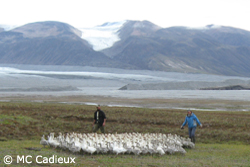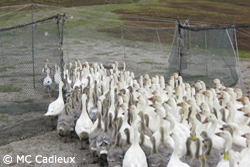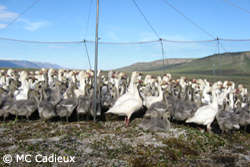The monitoring project of marked individuals is part of a long term study of Greater Snow Geese based at Université Laval since the early 80s. Most birds marked with a yellow, green or grey plastic collar are adult females but some adult males (partners of green collar females) were also marked with a collar. Based on this long term project we are able to study the survival, the reproduction and the migration of Greater Snow Geese with simple observations of marked individuals. These birds can be observed throughout their migratory flyway but mostly on their breeding grounds in the Arctic, on their staging areas in Quebec and on their wintering grounds in the United-States.
Since the early 90s, most geese are banded on Bylot Island (Nunavut), the main nesting site of the population. At the end of the summer, when adults are moulting (regeneration of their flight feathers) and goslings, hatched earlier in the season, are unable to fly, many goose families are captured. We round them up with a few people and lead them towards big holding pen where we can band them.
 |
 |
 |
Some years since 1993, geese are also banded during their fall or spring stopover along the St. Lawrence River. At that time, since geese can fly, we use a different approach and capture them in rocket nets triggered remotely.
Geese are held in pens for a few hours while we determined their sex, measured and weighed them and install a metal band on one of their legs. In addition, a few hundred adult females are marked every year with a yellow collar with a unique alphanumerical code. Geese from each catch are released, all at the same time, to insure that family members remain together.
On a few occasions, for specific studies on migration patterns of Greater Snow Geese, we also marked some adult females with radio-transmitters. These transmitters were glued on green collar or part of a special grey plastic collar with a unique alphanumerical code.
By visiting our website, you will be able to obtain some information on these collared geese. If you ever see one of those geese, you can send us your observations. Any additional observations (past or present) that we get are very useful to help us better understand the population dynamics of Greater Snow Geese. You can submit your sightings directly on our website by filling out our sighting form or send them by mail or by email to our banding manager. You can also take a look at our observation protocol to obtain more information on what kind of data are the most useful to us.
Thank you for your precious collaboration.